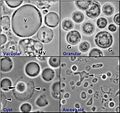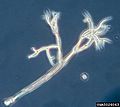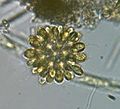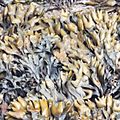Heterokont facts for kids
Quick facts for kids Heterokonts |
|
|---|---|
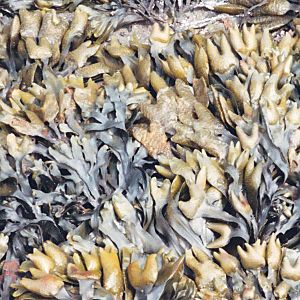 |
|
| Pacific rockweed, Fucus distichus, in Olympic National Park | |
| Scientific classification | |
| Domain: | |
| Kingdom: | |
| Phylum: |
Heterokontophyta
|
| Typical classes | |
|
|
The heterokonts (also called stramenopiles) are a huge group of tiny living things called eukaryotes. Eukaryotes are organisms whose cells have a nucleus. There are more than 100,000 different kinds of heterokonts! Most of them are diatoms, which are a type of tiny algae.
Heterokonts are mostly algae, which are simple plant-like organisms that live in water. At one point in their life cycle, they have two special tails called flagella. These flagella are different sizes. Heterokonts can be single-celled, like diatoms, or much larger, like brown algae. Brown algae include big seaweeds such as kelp and Sargassum. They are part of the Kingdom Chromalveolata.
Contents
What are Heterokonts?
Heterokonts are a very diverse group of organisms. This means they come in many different shapes and sizes, and they live in many different places. Some are tiny, single-celled creatures that float in the ocean. Others are large, plant-like seaweeds that you might see on a beach.
A key feature of heterokonts is their flagella. Flagella are like tiny whips or tails that help cells move around. In heterokonts, one flagellum is usually long and has tiny hairs on it, while the other is shorter and smooth. This unique pair of flagella is how they got their name, "heterokont," which means "different poles."
Types of Heterokonts
Heterokonts are divided into two main groups based on whether they have color or not.
Colored Heterokonts (Algae-like)
Most heterokonts are colored because they contain chlorophyll and other pigments. These pigments help them make their own food using sunlight, just like plants do. This process is called photosynthesis. These colored heterokonts are often called algae.
- Diatoms: These are tiny, single-celled algae with beautiful glass-like cell walls. They are super important in the ocean because they produce a lot of the oxygen we breathe.
- Golden Algae: These algae get their name from their golden-brown color. They are often found in fresh water and can sometimes form blooms.
- Brown Algae: This group includes many large seaweeds, like kelp. Brown algae are common in cooler ocean waters and can form huge underwater forests. They are an important food source and habitat for many sea creatures.
- Yellow-Green Algae: These are mostly found in fresh water and soil. They are less common than other algae but are still an important part of many ecosystems.
Colorless Heterokonts (Fungus-like)
Some heterokonts do not have color. This means they cannot make their own food using sunlight. Instead, they get their food by absorbing nutrients from their surroundings, much like fungi.
- Water Moulds (Oomycetes): These organisms can cause diseases in plants and animals. A famous example is the mould that caused the Great Famine in Ireland by destroying potato crops.
- Slime Nets (Labyrinthulomycetes): These are interesting organisms that form a network of slime to move and absorb food. They are often found in marine environments.
Life Cycle
Many heterokonts have complex life cycles. This means they go through different stages as they grow and reproduce. For example, some might start as a single cell with flagella, then grow into a larger, more complex form, and then release new cells to start the cycle again. The presence of two unequal flagella is a key feature seen in at least one stage of their life cycle.
Importance of Heterokonts
Heterokonts play many important roles in nature:
- Food Source: Diatoms and other algae are at the bottom of the food chain in many aquatic environments. They provide food for tiny animals, which are then eaten by larger animals.
- Oxygen Production: Diatoms produce a significant amount of the oxygen in Earth's atmosphere through photosynthesis.
- Habitats: Large brown algae, like kelp, create underwater forests that provide shelter and food for many marine animals.
- Decomposers: Some colorless heterokonts, like water moulds, help break down dead organic matter, recycling nutrients in the environment.
Images for kids
-
Peronospora sparsa (Oomycetes)
-
Potatoes with Phytophthora (Oomycetes)
-
Dinobryon sp. (Chrysophyceae)
-
Vaucheria (Xanthophyta)
-
Fucus distichus (Phaeophyceae)
-
Pelagophycus porra (Phaeophyceae)
See also
 In Spanish: Heterokonta para niños
In Spanish: Heterokonta para niños



